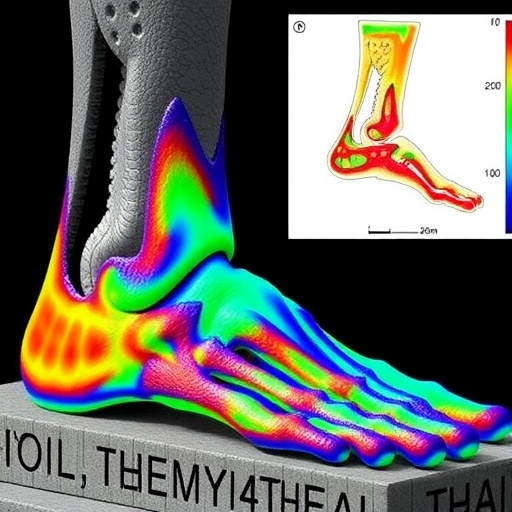For over a century, the enigma of human origins has captivated scientists, compelling them to meticulously analyze fossil records to unravel the evolutionary journey from primal ancestors to Homo sapiens. A groundbreaking study recently published in Communications Biology on October 15, 2025, by a team from Washington University in St. Louis breathes new life into this quest. Led by biological anthropologist Thomas (Cody) Prang, this research reexamines the locomotor abilities of one of the oldest known hominin fossils, Ardipithecus ramidus — colloquially known as “Ardi” — challenging longstanding interpretations about our evolutionary heritage and refining our understanding of the earliest chapters of hominin evolution.
Discovered in 1994, Ardipithecus ramidus represents a pivotal character in human evolutionary history, with a fossil age estimated at approximately 4.4 million years — nearly one million years predating the iconic Australopithecus afarensis specimen, “Lucy.” Ardi’s skeleton is remarkably complete, providing an unparalleled window into the morphology and locomotion of early hominins. Unlike Lucy, whose features have long been associated with bipedalism, Ardi has presented the scientific community with a mosaic of traits that straddle the divide between ape-like climbers and upright walkers, posing questions about the exact nature of locomotion that preceded modern human walking.
In this new study, Prang and his colleagues reassessed Ardi’s ankle morphology, focusing specifically on the talus bone, a critical component in the ankle joint that plays a central role in weight-bearing and mobility. The talus acts as a biomechanical fulcrum interfacing between the leg and the foot, shaping how forces are transmitted during locomotion. By employing comparative analyses between Ardi’s ankle bones and those of extant African apes — chimpanzees and gorillas — as well as other primates and early hominins, the research team unveiled unexpected congruencies that challenge previous assumptions about Ardi’s place on the evolutionary tree.
Earlier interpretations had posited that Ardi developed a form of generalized locomotion distinct from that of living African apes. This hypothesis diminished the likelihood of ancestral locomotor similarities, instead suggesting a divergent path that distanced Ardi’s movement from the vertical climbing and quadrupedal behaviors typical of chimpanzees and gorillas. Contrarily, Prang’s meticulous examination revealed that Ardi’s talus shares pronounced similarities with African apes, particularly in adaptations facilitating vertical climbing and plantigrade quadrupedalism — a mode of locomotion characterized by walking on four limbs with the entire foot sole in contact with the ground, including the heel.
This discovery implies a complex locomotor repertoire for Ardi, encompassing not only arboreal climbing but also the emergent adaptations that would lead to efficient bipedalism. Intriguingly, Ardi’s ankle displays indications of an enhanced push-off mechanism, a feature essential for propelling the body forward during walking. This blend of morphological traits reflects an evolutionary stage where early hominins possessed a versatile combination of climbing and terrestrial locomotion capabilities, bridging the behavioral gap between tree-dwelling ancestors and terrestrial bipeds.
The technical significance of these findings transcends a mere anatomical comparison. The talus morphology provides vital clues about the biomechanics of locomotion in hominins who existed in an epoch where the divergence between ape and human lineages was still crystallizing. The presence of African ape-like features in Ardi suggests that the last common ancestor shared by humans and chimpanzees likely exhibited similar climbing behaviors, thereby revising previous narratives that positioned modern African apes as evolutionary dead ends with little relevance to human ancestry.
Such revelations provoke a reevaluation of the evolutionary pathways that gave rise to unique human traits, especially our hallmark bipedalism. The entanglement of arboreal and terrestrial locomotor adaptations in Ardi’s anatomy intimates that bipedalism evolved gradually, emerging from ancestors still proficient in vertical climbing, rather than from a sudden shift to exclusive terrestrialism. This nuanced understanding enriches paleoanthropologists’ perspectives on habitat utilization, survival strategies, and selective pressures shaping early hominin mobility.
Prang emphasizes that while their research confirms affinities between Ardi and African apes, it does not claim that modern chimpanzees are our direct ancestors. Instead, the data underscore that the common ancestor likely resembled today’s chimpanzees more closely than previously assumed. The evolutionary divergence, therefore, might have involved modifications built upon this ancestral framework rather than wholesale departures from an unape-like baseline.
The study harnessed a multidisciplinary approach, integrating high-resolution three-dimensional imaging, geometric morphometrics, and functional morphology. Such methods allowed detailed quantification of angular relationships, articular surface curvatures, and leverage mechanics of ankle bones, furnishing insights into locomotor capabilities with unprecedented precision. By situating Ardi’s talus within the broader primate comparative context, the researchers elucidated evolutionary trajectories and biomechanical constraints that shaped hominin locomotion.
Contributors to this landmark study include Matthew W. Tocheri from Lakehead University in Canada, Biren A. Patel of the University of Southern California, Scott A. Williams from New York University, and Caley M. Orr at the University of Colorado Anschutz. Together, this collaborative effort signifies a vital cross-institutional endeavor aimed at refining our grasp of early hominin biology and evolution.
The implications of this research ripple beyond academic circles, enriching our collective understanding of human origins with evidence that fortifies the complexity and richness of evolutionary processes. Ardi’s revised locomotor portrait underscores a dynamic evolutionary narrative, marked by gradual transitions and functional mosaics rather than linear progressions. It invites both scientists and the public to rethink how our ancestors adapted to shifting environments and navigated the evolutionary crossroads that eventually culminated in the rise of Homo sapiens.
As this study resonates through the paleoanthropological community, it exemplifies how revisiting and reassessing fossil evidence with novel methods can challenge entrenched paradigms, fueling the steady march towards answering humanity’s most profound question: “Where do we come from?”
Article Title: Ardipithecus ramidus ankle provides evidence for African ape-like vertical climbing in the earliest hominins
News Publication Date: October 15, 2025
Web References:
Image Credits: WashU
Keywords: Homo sapiens, Anthropology, Human Evolution, Ardipithecus ramidus, Bipedalism, Paleoanthropology, Talus Bone, Locomotion, Primate Evolution




